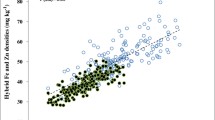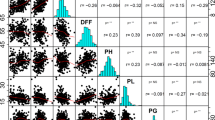Abstract
Pearl millet [Pennisetum glaucum (L.) R. Br.] is a major warm-season cereal, grown primarily for grain production in the arid and semi-arid tropical regions of Asia and Africa. Iron (Fe) and zinc (Zn) deficiencies have been reported to be a food-related primary health problem affecting nearly two billion people worldwide. Improving Fe and Zn densities of staple crops by breeding offers a cost-effective and sustainable solution to reducing micronutrient malnutrition in resource poor communities. An understanding of the genetics of these micronutrients can help to accelerate the breeding process, but little is known about the genetics and heterosis pattern of Fe and Zn densities in pearl millet. In the present study, ten inbred lines and their full diallel crosses were used to study the nature of gene action and heterosis for these micronutrients. The general combining ability (GCA) effects of parents and specific combining ability (SCA) effects of hybrids showed significant differences for both of the micronutrients. However, the predictability ratio (2σ2gca/(2σ2gca + σ2sca)) was around unity both for Fe and Zn densities, implying preponderance of additive gene action. Further, highly significant positive correlation between mid-parent values and hybrid performance, and no correlation between mid-parent values and mid-parent heterosis confirmed again the predominant role of additive gene action for these micronutrients. Barring a few exceptions with one parent, hybrids did not outperform the parents having high Fe and Zn levels. This showed that there would be little opportunity, if any, to exploit heterosis for these mineral micronutrients in pearl millet. In general, high Fe and Zn levels in both of the parental lines would be required to increase the probability of breeding high Fe and Zn hybrids.



Similar content being viewed by others
References
Arnold JM, Bauman LF (1976) Inheritance and interrelationships among maize kernel traits and elemental contents. Crop Sci 16:439–440
Baker RJ (1978) Issues in diallel analysis. Crop Sci 18:533–536
Burton GW (1974) Factors affecting pollen movement and natural crossing in pearl millet. Crop Sci 14:802–805
Gorsline GW, Thomas WI, Baker DE (1964) Inheritance of P, K, Mg, Cu, B, Zn, Mn, Al and Fe concentrations by corn (Zea mays L.) leaves and grain. Crop Sci 4:207–210
Gregorio GB (2002) Progress in breeding for trace minerals in staple crops. J Nutr 132:500–502
Griffing B (1956) Concept of general and specific combining ability in relation to diallel crossing systems. Aust J Biol Sci 9:463–493
Jorhem L (1993) Determination of metals in foodstuffs by atomic absorption spectrophotometry after dry ashing: NMKL Inter-laboratory study of lead, cadmium, zinc, copper, iron, chromium and nickel. J AOAC Int 76:798–813
Long JK, Banziger M, Smith ME (2004) Diallel analysis of grain iron and zinc density in southern African-adapted maize inbreds. Crop Sci 44:2019–2026
Mula RP, Rai KN, Kulkarni VN, Singh AK (2007) Public-private partnership and impact of ICRISAT’s pearl millet hybrid parents research. J SAT Agric Res 5:4–8
Parthasarathy Rao P, Birthal PS, Reddy BVS, Rai KN, Ramesh S (2006) Diagnostics of sorghum and pearl millet grains-based nutrition in India. Int Sorghum Millets Newsl 47:93–96
Velu G, Rai KN, Muralidharan V, Kulkarni VN, Longvah T, Raveendran TS (2007) Prospects of breeding biofortified pearl millet with high grain iron and zinc content. Plant Breed 126:182–185
WHO (2002) Reducing risks and promoting healthy life. The World Health Report. World Health Organization, Geneva, p 168. http://www.who.int/whr/2002/en/
Zhang Y, Kang MS, Lamkey KR (2005) DIALLEL-SAS05: a comprehensive program for Griffing’s and Gardner–Eberhart analyses. Agron J 97:1097–1106
Acknowledgments
This research was conducted as a part of a Ph.D. thesis of the senior author submitted to Tamil Nadu Agricultural University, Coimbatore 641003, India. It was funded by a grant from HarvestPlus Challenge Program of the Consultative Group on International Agricultural Research (CGIAR).
Author information
Authors and Affiliations
Corresponding authors
Rights and permissions
About this article
Cite this article
Velu, G., Rai, K.N., Muralidharan, V. et al. Gene effects and heterosis for grain iron and zinc density in pearl millet (Pennisetum glaucum (L.) R. Br). Euphytica 180, 251–259 (2011). https://doi.org/10.1007/s10681-011-0387-0
Received:
Accepted:
Published:
Issue Date:
DOI: https://doi.org/10.1007/s10681-011-0387-0




